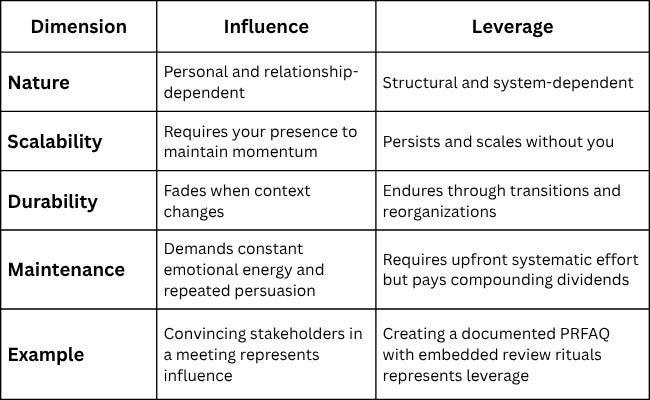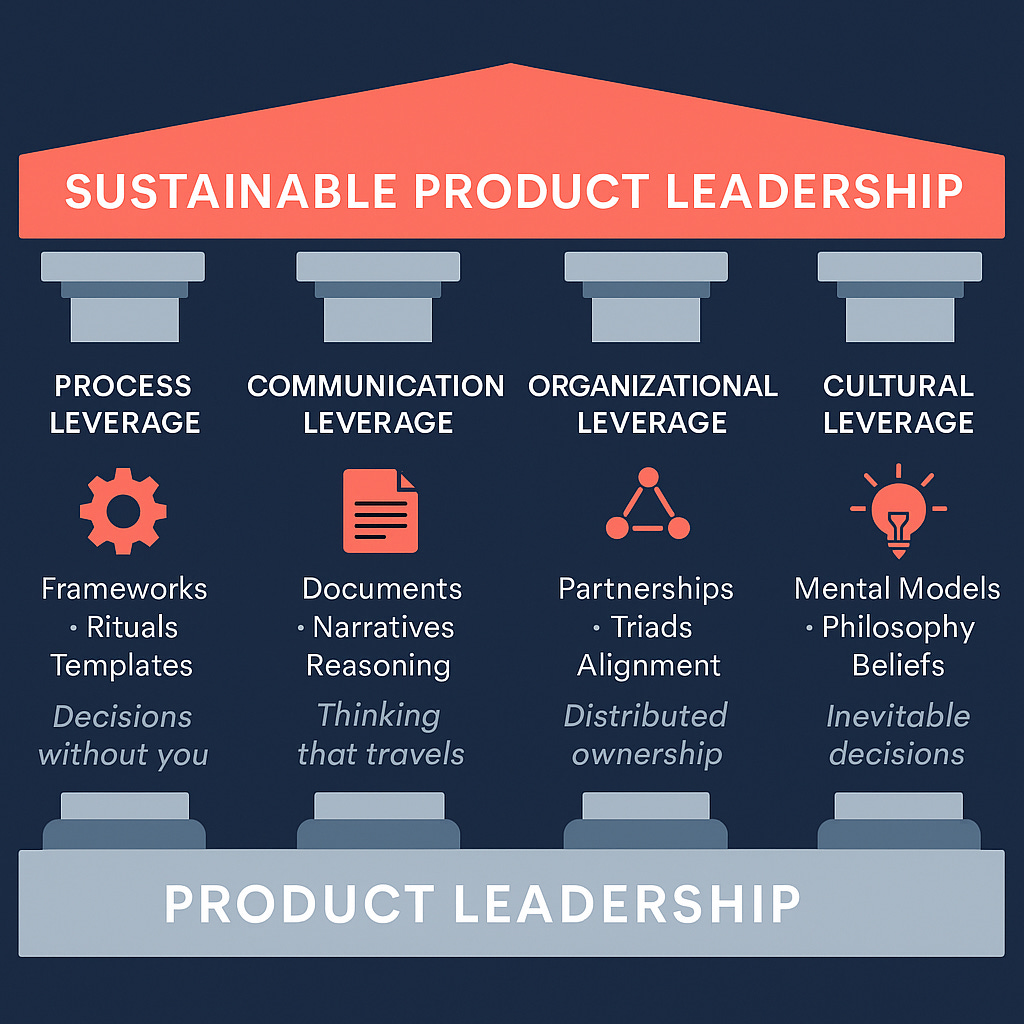Influence Without Authority Isn't Enough: You Need Leverage
How to Build Systems That Scale Your Product Decisions Without You
🎧 Podcast Conversation
In this episode of The Product Leader's Playbook, our AI hosts explore why successful product managers build systematic leverage rather than relying on personal influence, breaking down the four pillars that create durable, scalable product decisions.
→ Listen now on Spotify, Apple Podcasts, YouTube, or Amazon Music
"To be taken seriously, you must build what is durable. The ephemeral may inspire, but it does not endure."
— Roger Scruton
Product managers face a persistent challenge that grows more acute as companies scale: how do you drive meaningful product decisions when your influence depends entirely on being in the room? The traditional answer, "influence without authority," has become product management orthodoxy. We celebrate PMs who can rally engineers, sway VPs, and pitch roadmaps with no direct control over execution teams.
But this framing masks a critical problem for product leaders. Influence may secure short-term wins, but it creates unsustainable operating models that collapse the moment you step away. When your product strategy lives in your head rather than in durable systems, you become the bottleneck to your own success.
After leading products at Amazon and observing hundreds of PMs across different organizations, the pattern is clear: the most effective product leaders don't just persuade. They build leverage. They create systems that compound buy-in over time and make good product decisions inevitable, even in their absence.
The Hidden Cost of Influence-Only Leadership
Influence is interpersonal by nature. It relies on trust, timing, and your ability to tailor messages to room dynamics. When executed well, it can win alignment for feature launches or rally support for strategic pivots. But influence is also high-maintenance, doesn't scale, and disappears when you do.
This becomes problematic in fast-moving environments where stakeholders rotate quarterly, priorities shift with market conditions, and leadership changes can reset entire strategic contexts. If your roadmap is held together by charisma and recurring persuasion, it's fundamentally fragile.
You can identify influence-dependent PMs by their patterns. Their projects advance only when they're present in meetings. Momentum stalls during their vacation weeks. They spend more time preparing slide decks than refining product strategy because they're constantly reselling the same ideas to rotating decision-makers. Most tellingly, their best initiatives get deprioritized or abandoned within months of their departure.
I’ve witnessed this pattern repeatedly during rapid growth years. PMs who relied solely on influence found their carefully built consensus evaporating during reorganizations. Their projects survived only as long as their immediate manager remained in place. Meanwhile, PMs who had built leverage saw their initiatives continue scaling across teams, surviving leadership changes, and maintaining strategic priority even when they moved to different product lines.
The difference wasn't the quality of their ideas or their persuasive abilities. It was the presence of systematic leverage.
Understanding True Leverage in Product Leadership
If influence is the match, leverage is the infrastructure that sustains the fire long after you've left the room.
Leverage refers to repeatable structures that make your product thinking more durable, scalable, and independent of your direct involvement. It transforms good ideas into lasting initiatives that live within team rituals, shared documents, organizational culture, and decision-making frameworks rather than depending on your continued presence and persuasion.
The distinction becomes clear when you examine how influence and leverage operate across key dimensions of product leadership:
The most effective product leaders at Amazon didn't just present compelling ideas. They institutionalized their thinking in PRFAQs, leadership reviews, and product mechanisms. Their work outlived reorganizations. Their decisions scaled through other teams. Their roadmaps didn't require constant defense because the rationale had been codified, connected to customer impact, and embedded in shared systems.
This systematic approach to leverage wasn't accidental. It was the difference between good PMs and great product leaders.
The Four Pillars of Product Leadership Leverage
Product leadership leverage manifests across four interconnected areas that compound to create sustainable influence:
Process Leverage
This includes decision-making frameworks, product rituals, and document templates that enable others to evaluate tradeoffs using your thinking patterns. Examples include standardized roadmap shaping sessions, asynchronous RFC processes, default prioritization matrices that encode your judgment into the team's operating cadence, and launch checklists that embed your quality standards into execution workflows.
At Amazon, the most effective PMs created "mechanisms": recurring processes that surfaced the right information at the right time to drive consistent decision-making. These weren't bureaucratic overhead but systematic approaches that made good product decisions more likely and scalable.
Communication Leverage
Clear, narrative-style documents like PRFAQs, working-backwards memos, and vision statements allow your reasoning to travel without you. They don't just explain what the team is building. They articulate why it matters to customers, how it aligns with business goals, what tradeoffs were considered, and what success looks like.
The key is moving from presentation-style communication to document-driven clarity. Well-written strategy docs can travel across teams, persist through turnover, and serve as a record of aligned intent. When decisions live in documents instead of in meetings, they become easier to track, easier to revisit, and less dependent on live debate.
Organizational Leverage
Strategic partnerships with Design, Engineering, and Operations teams ensure your priorities become cross-functional by default. Strong triads, embedded rituals, and shared accountability structures distribute ownership and make it harder for your product to be deprioritized or misunderstood.
This means investing in relationships that create structural alignment rather than transactional agreement. When your design partner understands the customer problem as deeply as you do, when your engineering lead can articulate the business rationale for technical decisions, and when your operations partners can explain the product vision to their teams, you've created organizational leverage.
Cultural Leverage
The most durable form of leverage is cultural. When a team shares mental models like "we measure customer outcomes, not output velocity" or "we launch in phases, not in perfection," you've created an environment where good product decisions happen without your intervention.
Cultural leverage emerges when your product philosophy becomes embedded in how the team thinks about problems, evaluates solutions, and makes tradeoffs. It's the difference between having to explain your reasoning every time versus having a team that intuitively applies your frameworks to new situations.
The Systematic Approach to Building Leverage
Building leverage isn't about adding bureaucracy to your product process. It's about being intentional in how you scale your thinking and decision-making. Here's the systematic approach that the most effective product leaders follow:
Step 1: Codify Your Product Thinking
Start by documenting your reasoning in ways that others can reuse and build upon. Don't just list roadmap items. Explain why they exist, what customer problems they solve, how they connect to business outcomes, and how success will be measured. Write strategy memos instead of slide decks. Use decision documents to record tradeoffs and rationale, not just outcomes.
The Amazon PRFAQ process exemplifies this approach. By starting with the customer press release and working backwards to the solution, PMs were forced to articulate the customer problem, define success metrics, and consider implementation challenges before writing a single line of code. The document became a shared reference point that could guide decisions across teams and time periods.
Well-written documents can travel across teams, persist through turnover, and serve as a record of aligned intent. If your team's decisions disappear the moment you're not in the room, you're missing the opportunity to scale your thinking systematically.
Step 2: Design for Default Alignment
The best PMs don't spend their time reselling the same ideas repeatedly. They create structures where alignment is the default state, not the exception that requires constant maintenance. Establish recurring rituals: roadmap previews, feedback loops, stakeholder office hours that surface misalignment early and reduce the need for reactive persuasion.
This also means investing heavily in asynchronous collaboration. When decisions live in documents instead of in meetings, they become easier to track, easier to revisit, and less dependent on live debate. Create shared dashboards, establish regular async reviews, and build feedback loops that don't require your presence to function effectively.
Step 3: Institutionalize Your Priorities
Good product thinking ties back to durable business outcomes and customer impact. Leverage is built when your decisions are anchored in company goals, customer metrics, and team incentives that persist beyond your tenure. If the roadmap can't be justified by metrics leadership already cares about, it won't survive a reorganization.
Push your decisions into systems: OKR trackers, sprint rituals, launch checklists, performance dashboards so they become part of how the team works, not just what they work on. Create feedback loops that surface customer impact regularly. Build measurement systems that make progress visible to stakeholders who don't interact with your product daily.
Step 4: Create Forcing Functions
The most powerful leverage comes from creating systems that make good decisions inevitable. This includes establishing clear decision-making frameworks, building customer feedback directly into product development cycles, and creating accountability structures that reinforce your product philosophy.
Examples include mandatory user research phases before feature development, required customer impact assessments for roadmap changes, and regular business reviews that tie product metrics to company goals. These forcing functions ensure that your product principles get applied consistently, even when you're not there to enforce them.
A Tale of Two Product Initiatives
The difference between influence and leverage becomes clear when you examine how product initiatives play out over time. Early in my career, I led two major product initiatives within six months of each other that illustrate this distinction perfectly.
The first was a customer-facing feature I believed would significantly improve user engagement. I built alignment through relentless persuasion: slide decks highlighting user pain points, hallway conversations with engineering leads, late-night messaging threads with design partners. The feature launched successfully and showed promising early metrics. But two quarters later, the project was quietly shelved during a prioritization review. There was no paper trail explaining the customer problem, no metric linkage to business outcomes, and no structure holding it up once priorities shifted and new stakeholders joined the team.
The second initiative took a different approach. I started with comprehensive documentation that outlined the customer problem, defined success metrics, and articulated the business rationale. I highlighted key tradeoffs and ran a series of asynchronous reviews with cross-functional partners. I linked the initiative to a company-wide OKR and built triad alignment into our sprint cadence. I created a dashboard that surfaced customer impact metrics and established regular business reviews that tied product progress to company goals.
Six months after launch, the feature was still growing and expanding to new customer segments despite the fact that I had already transitioned to a different product line. The initiative survived two reorganizations, a change in engineering leadership, and a shift in company priorities. New team members could understand the rationale, customer impact was visible to leadership, and the measurement systems provided ongoing validation of the approach.
The difference wasn't the quality of the idea, the market opportunity, or my persuasive abilities. It was the presence of systematic leverage that made the initiative durable and scalable beyond my direct involvement.
From Convincing to Compounding
The job of a product manager isn't just to convince people of good ideas. It's to create the conditions where good decisions become inevitable and compound over time. This requires more than influence. It requires systematic thinking about how to scale your judgment and decision-making.
Influence gets you in the room and wins short-term agreement. Leverage keeps your thinking alive and growing once you're gone. If you want to lead products at scale, stop building PowerPoints and start building systems.
The most successful product leaders understand that their role is to create durable structures that make great product decisions more likely, not to be the single point of failure for every important choice. They build leverage systematically, invest in systems that compound over time, and create conditions where their best thinking can scale beyond their direct involvement.
This isn't about reducing the importance of relationships or communication skills. It's about recognizing that sustainable product leadership requires more than personal influence. It requires systematic leverage that creates lasting impact.
Reflection Framework
To assess your current approach and identify leverage opportunities, consider these questions:
Where are you still relying on personal influence to drive product decisions? What systems could you put in place to make those same decisions scalable and durable?
What would happen to your key product initiatives if you took a month-long vacation tomorrow? Which ones would continue progressing, and which would stall?
How much of your strategic thinking exists only in your head versus being codified in documents that others can reference and build upon?
What recurring product debates could be resolved through better frameworks, clearer documentation, or systematic processes?
The answers will reveal where influence has been masking the need for leverage and where you have the biggest opportunities to build systems that compound your impact over time.
🎧 Want to Go Deeper?
This article is discussed in a podcast episode of The Product Leader's Playbook, streaming everywhere:
🔹Spotify |🔹Apple Podcasts |🔹YouTube |🔹Amazon Music




